News & Events
August 20, 2019
The 69th Lindau Nobel Laureate Meeting
by Vanessa Graber, postdoctoral fellow at the McGill Space Institute, Montreal, August 2019
For one week every year, the small island of Lindau is home to one of the greatest scientific events you could possibly imagine. Situated on the eastern side of Lake Constance in Bavaria, Germany, the city hosts the Lindau Nobel Laureate Meetings, aimed at bringing together Nobel Laureates and young scientists from all over the world to encourage scientific exchange between different cultures and generations.
These meetings, which were first established in 1951 by two local physicians and the support of Count Lennart Bernadotte, then owner of the nearby Mainau Island and member of the Swedish Royal Family with close connections to the Nobel Committee, focus on medicine, physics and chemistry, alternating annually between the three subjects.
The 69th Nobel Laureate Meeting concentrated on physics and took place in the first week of July this year. Among the many young scientists were thirteen participants from Canada, of which five others and I had been nominated by 2015 Nobel Prize winner Art McDonald. Financial support from the McDonald Institute, the Foundation for the Lindau Meetings and various partner organizations, allowed us to spend an incredible few days at this year’s Nobel Laureate Meeting in Lindau. Despite having grown up less than two hours from the island, I had not visited in almost two decades and forgotten how beautiful the city is with its old painted buildings, cobblestone roads, an iconic lighthouse in the old port and fantastic view of the Alps and Lake Constance – a beautiful scenery for a scientific meeting.
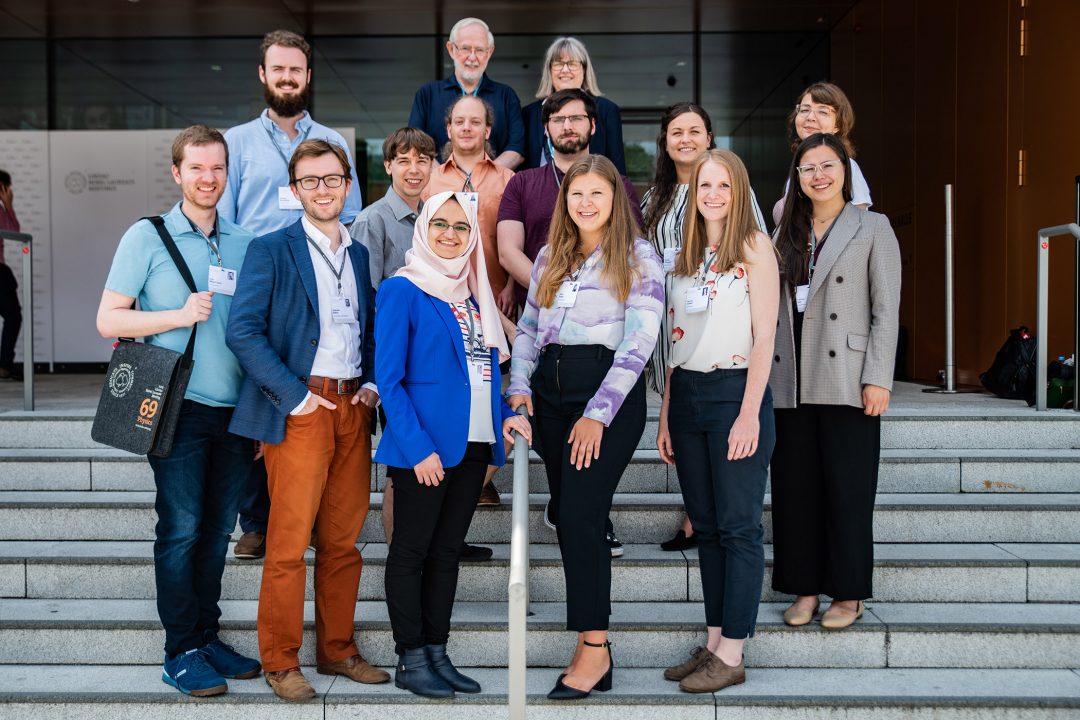
69th Lindau Nobel Laureate Meeting 03.07.2019 Photo/Credit: Patrick Kunkel/ Lindau Nobel Laureate Meetings
Day 1 - Sunday, June 30th
Like most of the participants, I arrived in Lindau by train. The journey provided many of us with the first chance of meeting some of the other attendees. If you were as lucky as Damian Goeldi, an experimental particle physicist originally from Switzerland and currently a postdoctoral researcher at Carleton University in Ottawa, your very first encounter was with none other than 2017 Nobel Laureate Rai Weiss, engaging you in a conversation about the role of large collaborations in modern scientific discoveries on your way to Lake Constance.
Following registration for the meeting, that we all unanimously agreed to be the best-organized one that we had ever attended (How often do you get a personalized agenda and a booklet with all the participants’ contact information and scientific interests?), the conference kicked off with the Welcome Ceremony in the Inselhalle, the main venue. In her first address, Countess Bettina Bernadotte, President of the Council for the Lindau Nobel Laureate Meetings that is responsible for the organisation, introduced us to the spirit of the meetings with their aim to “educate, inspire and connect”; a motto that brought together 39 Nobel Laureates and 580 young scientists from 89 countries this year. The following opening speech by Nobel Laureate Brian Schmidt, who shared the 2011 prize for providing evidence for an accelerated expansion of the Universe, had many important take-home messages, including his urge to make science open and reproducible to give scientific progress as much momentum as possible and have everyone benefit from it.
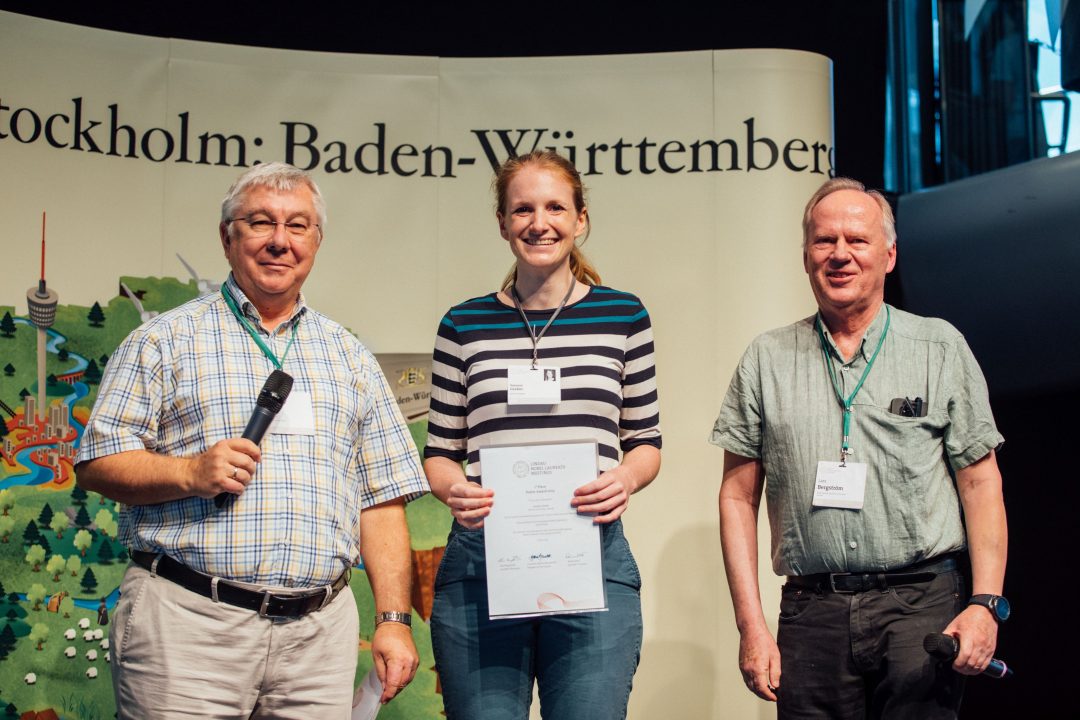
While the majority of the participants made their way to the city’s theatre after the Welcome Ceremony to enjoy the Opening Concert by an ensemble of the Vienna Philharmonic Orchestra, I joined 29 other young scientists to attend a coaching session for the poster flashes, which would be taking place the next day. We had been selected to present our research in poster sessions throughout the week and were practising how to best excite the audience about our work in two minutes. I would later win one of two first-place prizes for my poster on experimental probing of Neutron Stars.
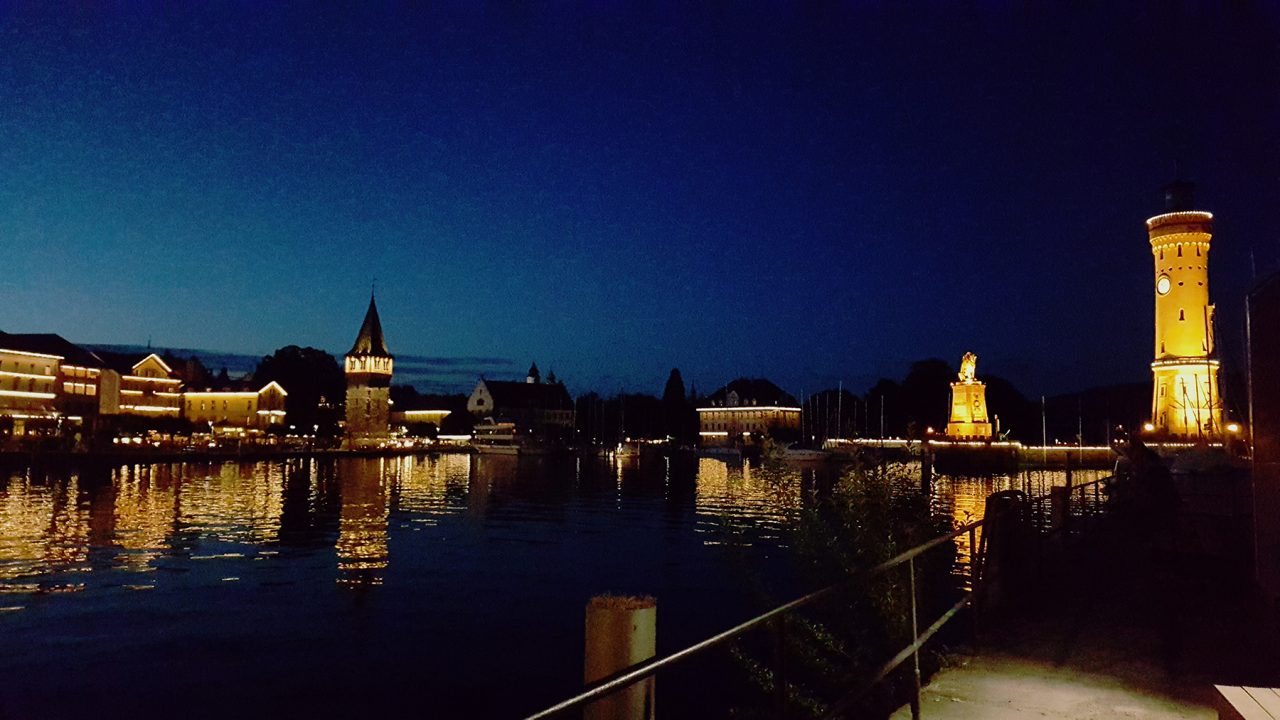
The first day of the meeting concluded with dinner and relaxed conversations at the Inselhalle, allowing us to get to know more about our fellow attendees and meeting the other young scientists from Canada for the first time. After an exciting day, several of the Canadian participants returned to their accommodation with the appropriate name ‘Alte Schule’, the city’s old school building that had been converted into a hotel. In addition to staying in hotels on the island and the local area, young scientists also had the option to stay with a local host family, an opportunity that Tetiana Kozynets, originally from Ukraine and a recent physics graduate from the University of Alberta in Edmonton, greatly appreciated.

Group photo of the Canadian participants, including Nobel Laureates Donna Strickland and Art McDonald. (Photo/Credit: Patrick Kunkel/Lindau Nobel Laureate Meetings)
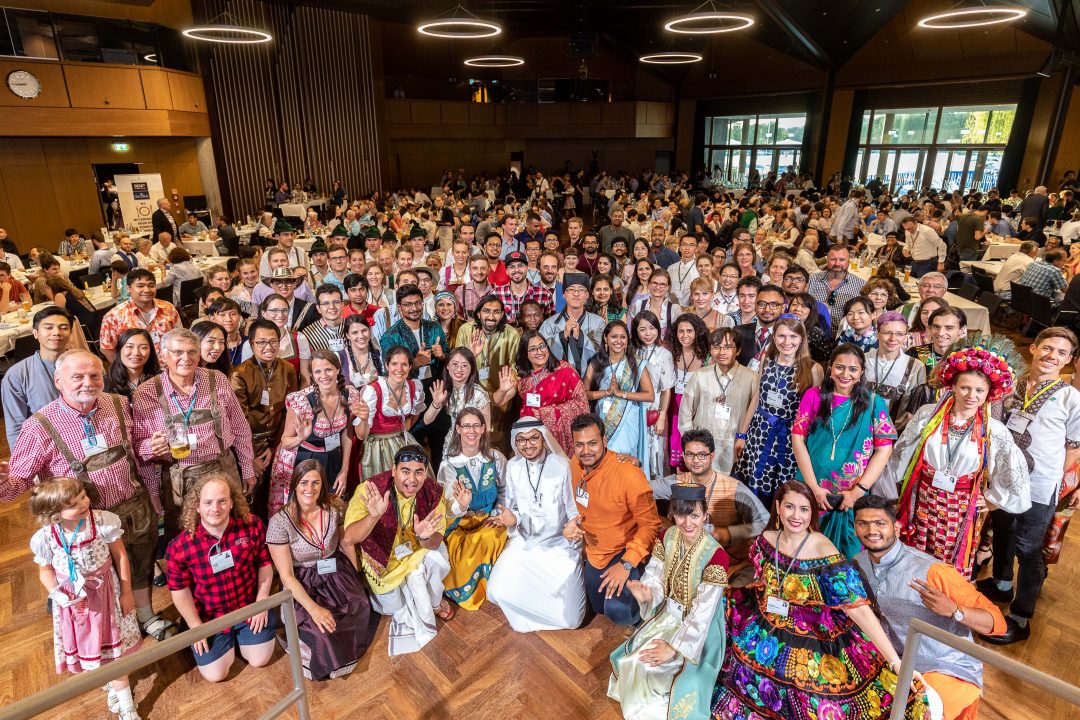
69th Lindau Nobel Laureate Meeting, 04.07.2019, Lindau, Germany, Picture/Credit: Christian Flemming/Lindau Nobel Laureate Meetings Bavarian Evening
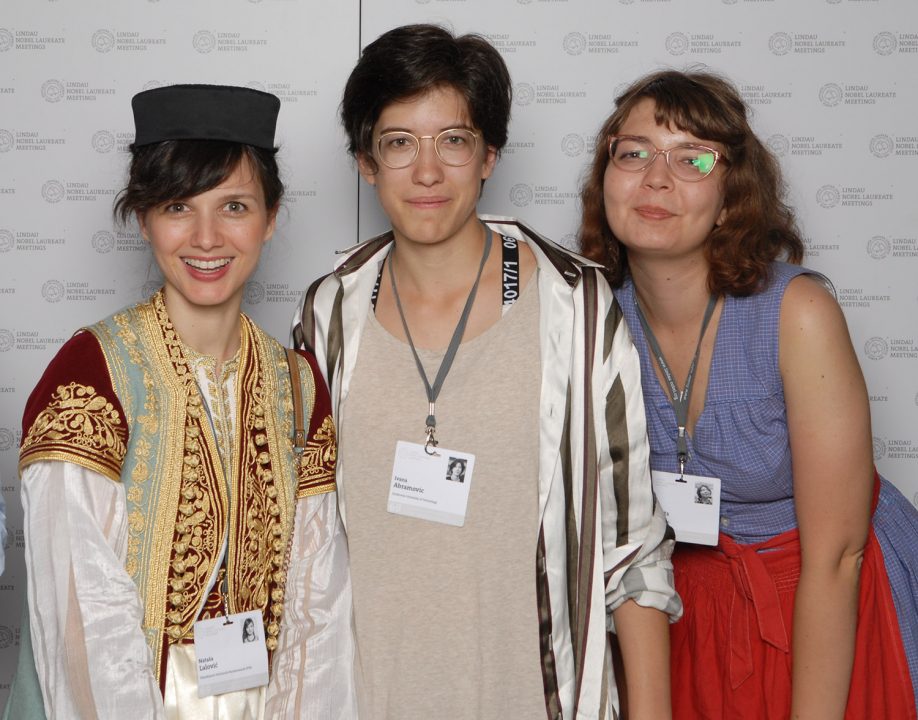
Day 2 - Monday, July 1st
Every year the Nobel Laureate Meeting has a partner country, which was South Africa for the 2019 event. The programme started with a South Africa hosted breakfast, which included the first-panel discussion on the topic of ‘Global Science in Reaching for the Stars’, in which the panellists discussed the critical role that science and specifically astronomy plays in South Africa. The country has become an increasingly important contributor to large international research efforts, manifest, for example, in the development of the Square Kilometre Array, a large-scale radio telescope project.
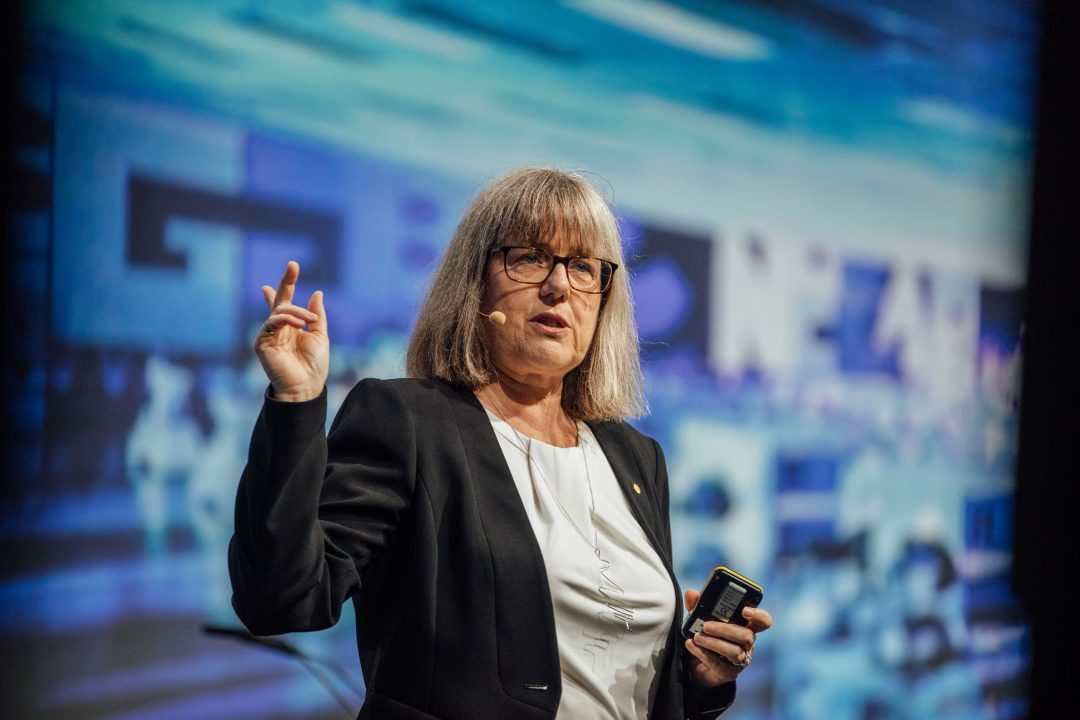
The partner breakfast was followed by the first lecture by Donna Strickland, who started her talk by wishing all Canadians a happy Canada Day; which was, of course, met with several cheers. Last year’s Nobel Prize winner not only gave us details about her contributions to the field of ultra-short laser physics but also her path as a researcher. It was great to see a (long overdue) female laureate give this first talk and learn that she was awarded the prize for the first paper, she published as a Ph.D. student; something Strickland had never anticipated.
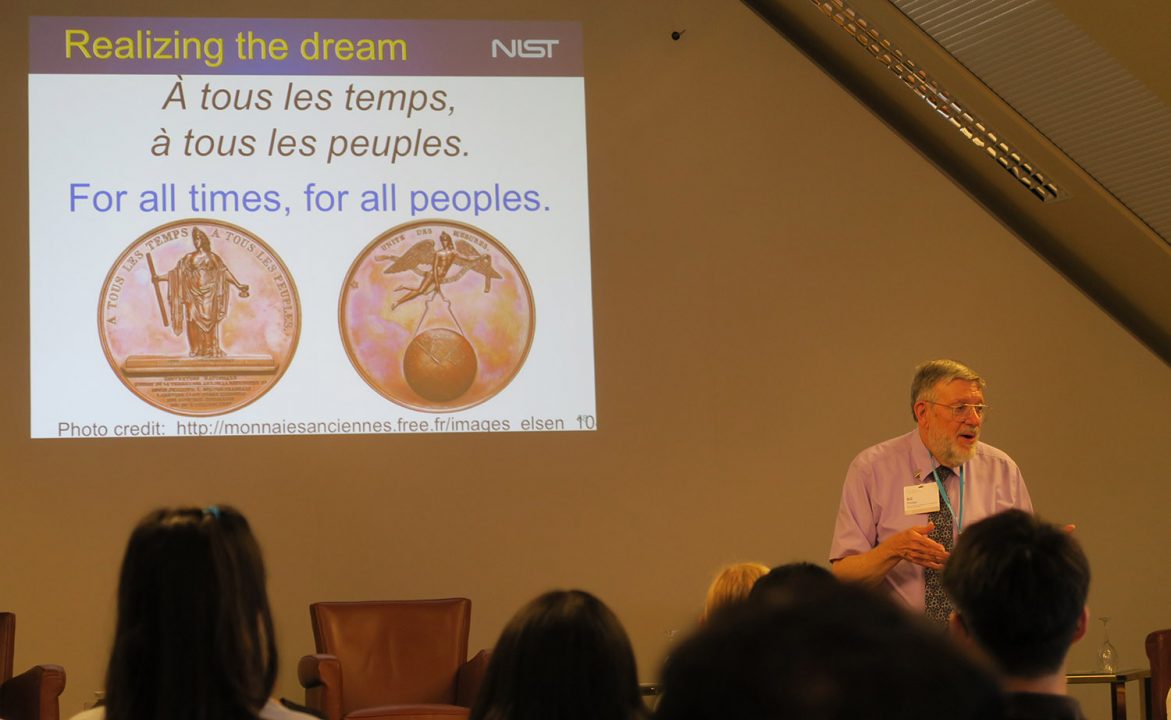
After the morning’s lectures, many of us attended a talk by Bill Phillips, who was awarded the Nobel Prize in 1997 for his work on laser cooling. In a very engaging manner, he gave us insights into the redefinition of the metric system, which had taken place in May this year and he referred to as the “greatest revolution since the French revolution.” The new definitions no longer rely on respective prototypes but are much more elegantly based on fundamental physical phenomena. Phillips presentation, which was one of the highlights for many young scientists during the week, specifically focused on the redefinition of the kilogram. The unit is no longer connected to the prototype kilogram, a small piece of platinum alloy located in a vault Paris, but instead related to fixed values of natural constants. Who would want a definition of the kilogram that could easily be changed by leaving a fingerprint?
One of the following talks was given by Carl Wieman, awarded the 2001 Nobel Prize for producing the first Bose-Einstein condensate. In addition to studying ultra-cold matter, Wieman has been working on science education and strongly encouraged us to rethink the way we teach physics, as current practices are entirely disconnected from the way we learn.
After lunch, young scientists had the opportunity to talk to the morning’s presenters in research-oriented discussion sessions called Open Exchange, which were an excellent opportunity to ask the laureates about their work as well as their wider understanding of academia and science. Canadian young scientist Tetiana used the Open Exchange to ask Stefan Hell, the recipient of the 2014 Nobel Prize in Chemistry for the development of super-resolved fluorescence microscopy, more about nano-scale imaging and the possibility of applying the technique in bubble chambers used for dark matter detection, her field of research. Tetiana said she was truly surprised that she became genuinely interested in a topic that, at first, seemed to have absolutely no connection to her research area and that talking to Hell about this informally was priceless; further highlighting one of the great advantages of the Lindau Meetings.
The afternoon of the second day concluded with our poster flashes in the old theatre of the city. The short presentations by 30 young scientists covered a wide spread of topics and creative research approaches, which would be discussed in more detail during the poster sessions in the following three days. We finished the evening with an international get together and dinner hosted by South Africa, which started with amazing performances by the dance group Marimboz and singer Nomfusi and finished with great conversations and drew many of the participants (including several of the Nobel Laureates) onto the dance floor.
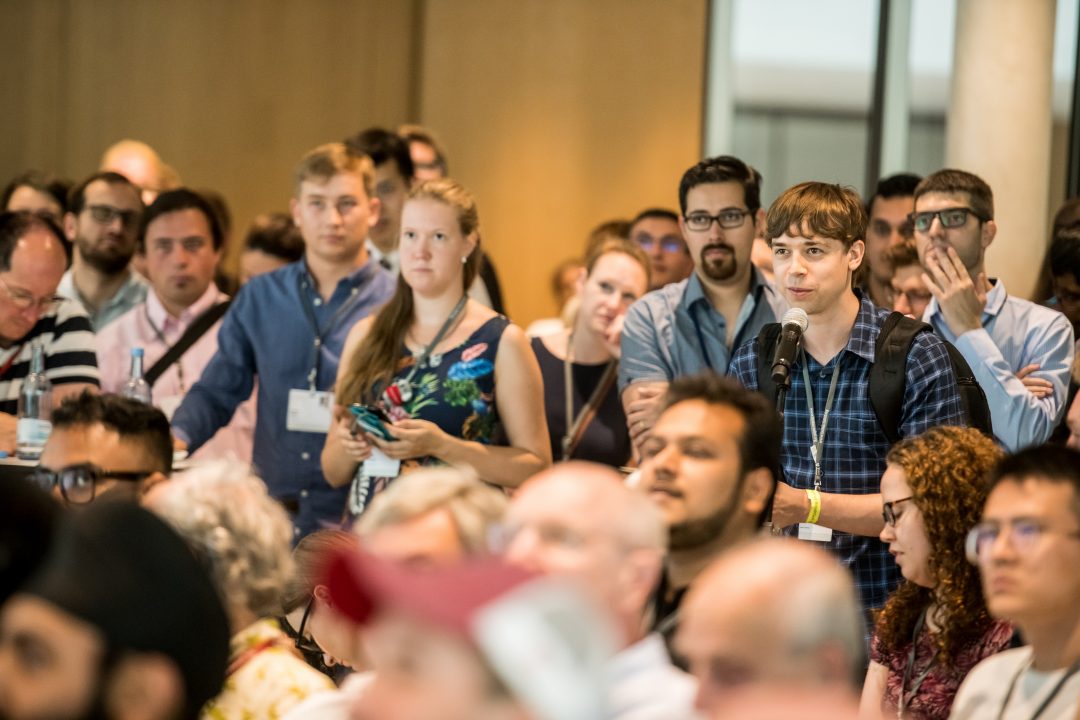
Young scientist Connor Stone asking a question during Nobel Laureate Bill Phillip's talk. (Photo/Credit: Patrick Kunkel/ Lindau Nobel Laureate Meetings)
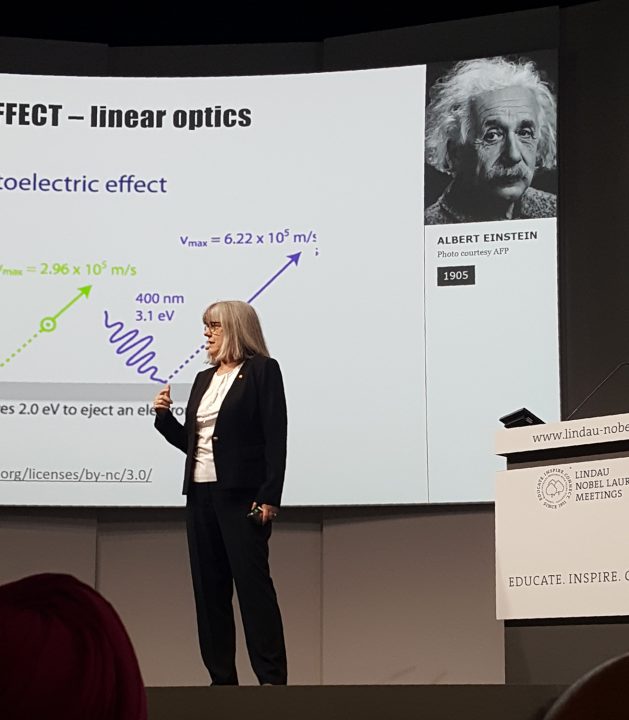
Donna Strickland
Day 3 - Tuesday, July 2nd
Following a morning yoga session with a view of Lake Constance, the third day centred on particle physics and astrophysics. The morning included a lecture by Art McDonald, 2015 Nobel Prize winner for the discovery of neutrino oscillations, which not only focused on his past work but also gave a promising outlook on upcoming experiments that aim to detect dark matter directly. The astrophysics theme was picked up by the speakers of the second morning session. The first lecture, including several anecdotes about how scientists can be wrong (including Einstein, who kept changing his mind about the existence of gravitational waves), was given by Joe Taylor. Taylor shared the Nobel Prize in 1993 for the discovery of a neutron star in a compact binary that allowed the first indirect detection of gravitational waves. The first time I came across this discovery was as a master student giving a seminar on gravitational waves, and even now, as an astrophysicist studying neutron stars, who has seen this measurement many times, I find its elegance absolutely stunning. Taylor’s lecture was proceeded by Rai Weiss, who shared the Nobel Prize in 2017 for his contributions to the LIGO detector and the first direct detection of gravitational waves, presenting the state of current and upcoming gravitational wave observatories.
After the lectures, the Canadian participants met for a special lunch with Donna Strickland and Art McDonald. We talked not only about their experiences and lives after winning the Nobel Prize but also the state of physics research in Canada, outreach initiatives at Canadian institutions and universities, and the value of networking. Tarnem Afify, a Canadian third-year biophysics student from York University in Toronto, highlighted that the “lunch meeting strengthened a sense of belonging to the amazing community of the Canadian team at the Lindau Meeting”, a connection that Art encouraged us to build upon once we are back in Canada.
The afternoon programme commenced with a panel discussion on The Dark Side of the Universe in which the panellists focused on the topics of dark matter and dark energy, addressing not only our fundamental understanding of the topics but also the more philosophical question of “Is the name dark really a good one?” One of the points that stood out the most to me was a statement by Brian Schmidt pointing out how important it is to fund theoretical work alongside large-scale observational efforts. As a theoretical physicist, I couldn’t agree more; a combination of both is essential to progress in science.
Following the final lecture of the day, many of the participants attended the first two out of four master classes, a concept typically known in the performing arts, where young scientists can present their work in front of a Nobel Laureate. I attended the master class by Carl Wieman on ‘Teaching Physics’ in which three young scientists presented their contributions on the subject, followed by feedback from the audience and the Nobel Laureate. Picking up on his talk from Tuesday, Wieman pointed out that one of the essentials in physics education should be to help students learn by practising making decisions and receiving valuable feedback, ideas that many of the attendees were keen to incorporate into their future teaching.
The third day concluded with a dinner hosted by the academic partners of the meeting. Three of the six young scientists sponsored by the McDonald Institute, including Helena Koniar from Canada a fourth-year biophysics student from McMaster University in Hamilton, were also supported by the Bayer Science & Education Foundation. During the evening, they learned more about the company’s use of machine learning in improving, for example, pharmaceuticals. My partner dinner was hosted by the Wilhelm and Else Hereaus Foundation, a private German foundation established in 1963 that supports education and scientific research primarily focusing on physics, and it was great to share a table with one of the directors, Ursula Hereaus, and learn about the origins of the foundation and their vision.
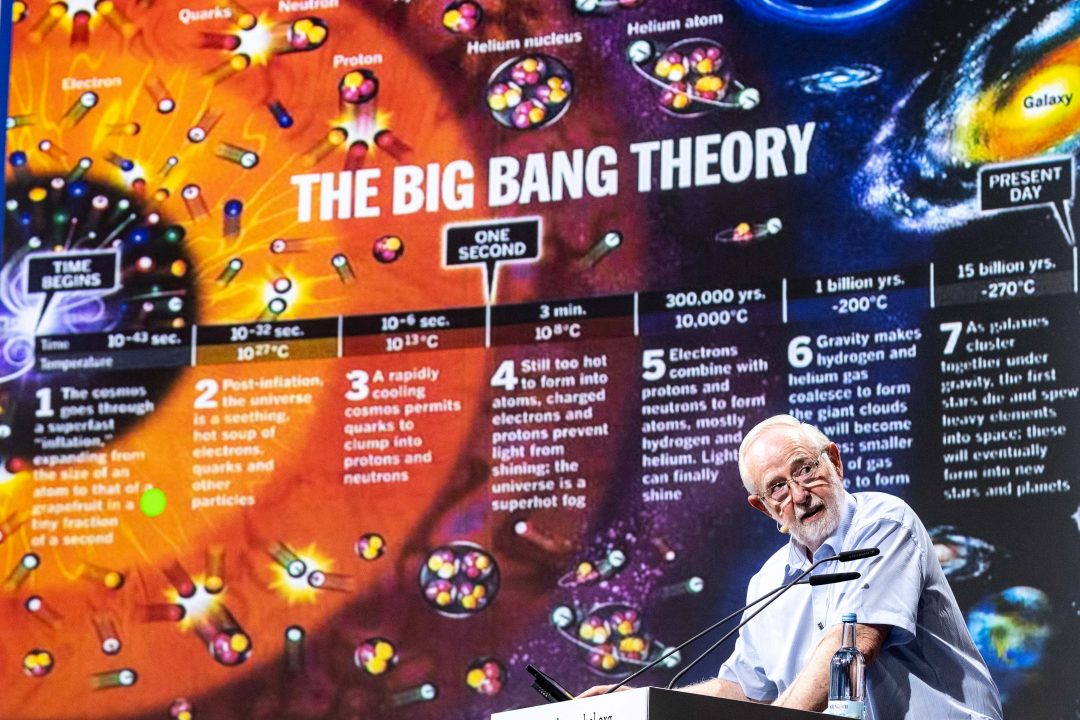
69th Lindau Nobel Laureate Meeting, 02.07.2019, Lindau, Germany, Picture/Credit: Christian Flemming/Lindau Nobel Laureate Meetings Lecture Arthur B. McDonald

Day 4 - Wednesday, July 3rd
After a breakfast panel discussion addressing the applications as well as the recent hype around graphene, the morning programme started with a great lecture by Nobel Laureate Michael Kosterlitz. He received the prize in 2016 for his work on condensed matter physics and told us how, as a slightly frustrated and ‘failed’ high-energy physicist (who was more interested in climbing mountains than physics), he was looking to work in a different research field. In his talk, Kosterlitz, who had found a new mentor in David Thouless encouraging him to study phase transitions from a new point of view, highlighted multiple times how lucky he was to have made this discovery, stressing that he was mainly at the right place at the right time; a very reassuring statement that we heard by several other speakers throughout the week.
This was followed by lectures on particle physics and applications of nuclear magnetic resonance spectroscopy. One of the speakers was David Gross, a theoretical physicist who shared the 2004 Nobel Prize for the discovery of asymptotic freedom, an important concept in particle physics. His talk captivated many of the young scientists including Connor Stone, a Canadian PhD student at Queen’s University in Kingston and coordinator at the university’s observatory who studies galaxy evolution. Connor, in particular, remembers Gross’ idea of representing knowledge and ignorance as the volume and surface of a sphere, respectively, highlighting that while “the more we know, the more we don’t know”, knowledge will also always grow faster than ignorance. Gross’ talk also reassured experimental particle physicist Damian that he had chosen the right field of research, feeling encouraged that “there is nothing more exciting than testing the very foundations of the universe in an experiment”
After lunch, it was my turn to present my research during the afternoon’s poster session. I talked to many interested young scientists from very different fields and answered questions about my work on neutron stars and their connections to laboratory quantum condensates. The diverse scientific backgrounds of the participants are one of the great achievements of the Lindau Meeting, allowing one to see one’s research from a different viewpoint, something that does not happen very often in a classical conference environment. The interdisciplinarity of the meeting was also crucial for Canadian participant Tarnem. With a huge passion for astrophysics and biophysics, two subjects that she rarely sees combined at the same meeting, Tarnem was very excited to meet other young scientists that share her interests, which she said sparked thousands of ideas in her mind.
The poster session was followed by another panel discussion on “Student, Postdoc, and Then? – Aiming for a Career in Science” in which the panellists talked about their experiences of the academic job market, from the arbitrariness of the hiring process to the fact that we have to stop to consider ”leaving academia” as a failure, especially since this will be the future for a vast majority of physics graduates. One argument that was made is the importance of encouraging students and postdocs to learn about opportunities outside of the academic bubble. The fact that the panel conversations went beyond the bare scientific content and also gave insight into personal stories, picking up on many of problems that academia is facing right now, made the Lindau Meeting even more important to many of the young scientists. While the panel discussion only touched on a few of the issues many academics are facing right now, topics like diversity, inclusion and mental health were heavily discussed amongst the participants over the entire week, showing how important these aspects are for us.
Following the second round of master classes, including one on “The Transient Universe” hosted by Brian Schmidt that was attended by several Canadian young scientists, the official programme concluded with the Heidelberg Lecture by 2015 Turing Award winner Martin Hellman, one of the inventors of public-key cryptography. The Heidelberg Laureate Forum is the corresponding event dedicated to mathematics and computational sciences. While no Nobel Prizes are awarded in these fields, the meetings bring together young scientists and winners of prestigious prizes such as the Abel Prize, the Fields Medal and the Turing Award. In his lecture on “The Technological Imperative for Ethical Evolution”, Hellman addressed our responsibilities as scientists in solving crucial problems of our time, such as climate change and the importance of nuclear disarmament.
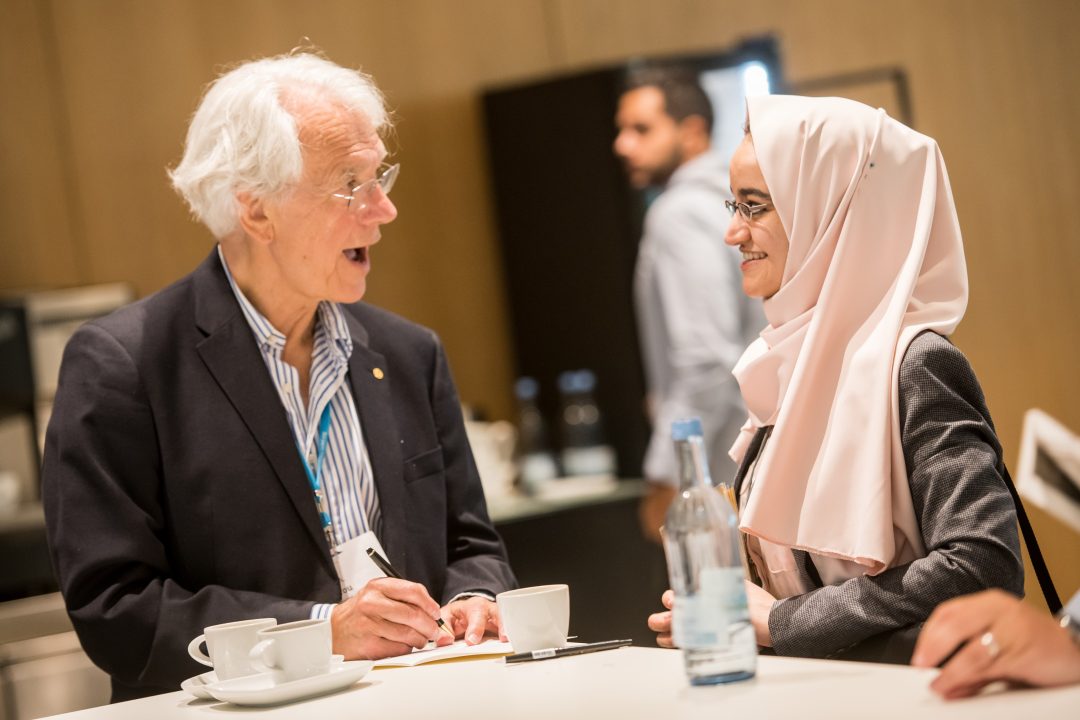
69th Lindau Nobel Laureate Meeting Photo/Credit: Patrick Kunkel/ Lindau Nobel Laureate Meetings 01.07.2019
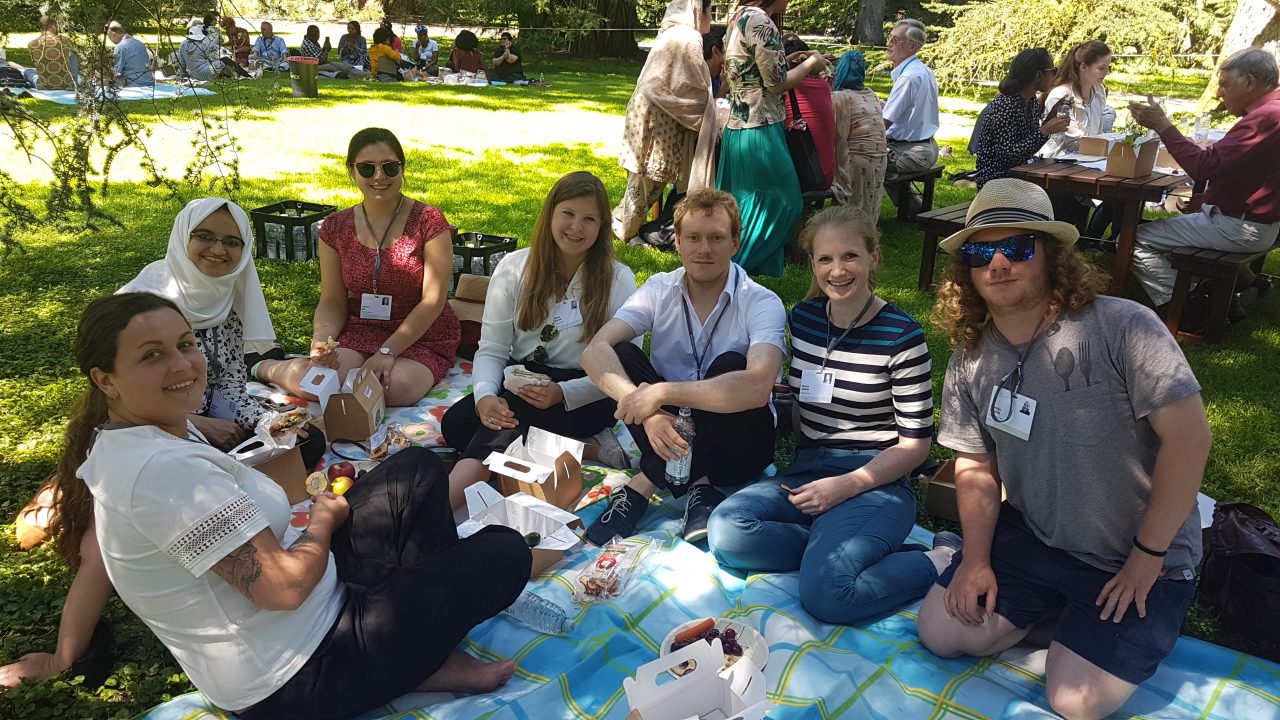
Day 5 - Thursday, July 4th
The final day of talks began with lectures on ultra-cold physics and laser spectroscopy, including an engaging presentation by Wolfgang Ketterle, who was awarded the Nobel Prize in 2001 for his work on ultra-cold gases. It continued with interesting talks on Scientific Blunders by Dan Shechtman the 2011 Nobel Laureate in Chemistry for the discovery of quasi-crystals, and a more detailed description of the newly defined SI system by Klaus von Klitzing, who won the 1985 Nobel Prize for discovering the quantised Hall effect. By showing us a video of an official visit to the international prototype kilogram, introduced by Bill Philips earlier in the meeting, von Klitzing made us all appreciate the neatness of the new SI definition, which was unanimously accepted by the General Conference on Weights and Measures earlier this year.
The final lecture of the meeting was given by Claude Cohen-Tannoudji, who shared the 1997 Nobel Prize for his contributions to laser cooling and trapping atoms. During a moving last presentation, Cohen-Tannoudji talked about his personal story and repeatedly highlighted the importance of his parents during his academic career, having instilled in him a love for learning and teaching.
Thursday marked not only the final day of Laureate Lunches, organised events where ten young scientists could join a laureate for lunch in Lindau, but also the last Science Walks. Following the final lunch at the Inselhalle, I met several fellow participants for such a walk with Nobel Laureate Joe Taylor. During the walk, a guide showed us around Lindau island and introduced us to many interesting facts about the city’s history. Meeting Taylor, the PhD advisor of Vicky Kaspi, whose group I am currently part of (and is thus what one could refer to as my ‘academic grandfather’), was a fascinating experience. I not only enjoyed talking about astrophysics, pulsars and fast radio bursts but also learning more about his personal story. Opportunities like this make the Lindau Meeting a genuinely unique experience.
The final event of the day was the Bavarian Evening with local music, folk dance and traditional Bavarian food. The dinner was not only a celebration of Bavarian culture but also the backgrounds of the young scientists as everyone was encouraged to wear their traditional costumes, resulting in an amazingly colourful show of outfits, highlighting the vast number of nationalities present at the meeting.
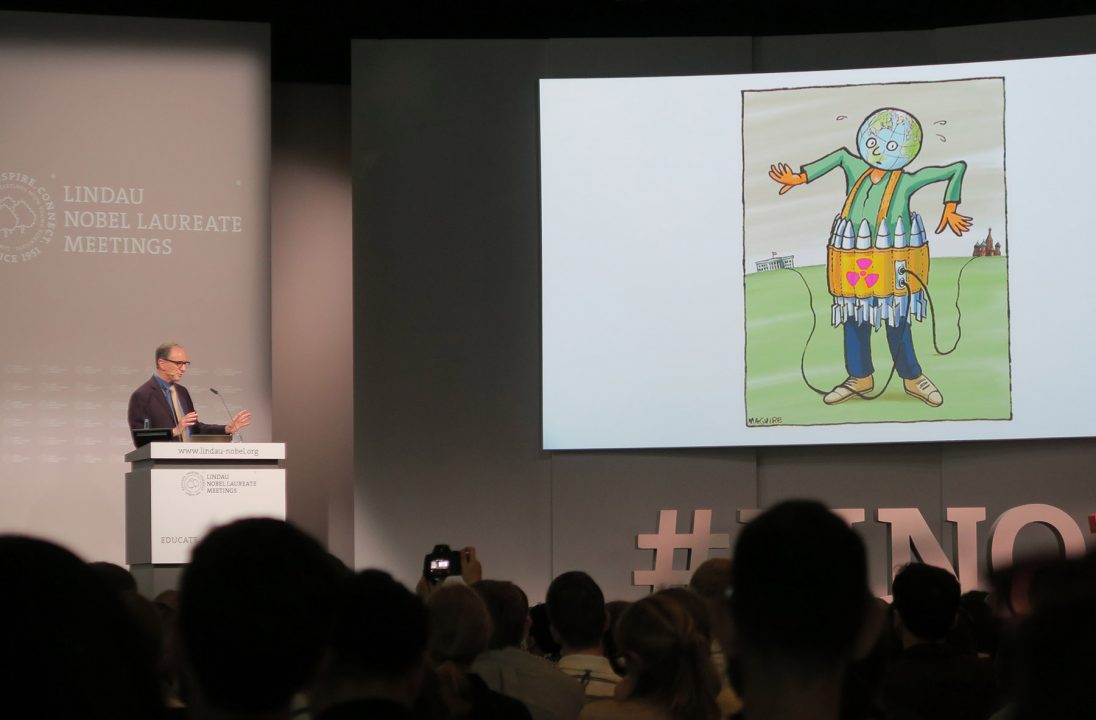

First get together of the participants outside the main venue on Lindau island. (Picture/Credit: Julia Nimke/Lindau Nobel Laureate Meetings)
Day 6 - Friday, July 5th
The final day of the Nobel Laureate Meeting started with us boarding the MS Sonnenkönigin for our boat trip to the Mainau, the home of the Bernadotte family, and garden island hosting many tree varieties, a butterfly house and blooming flowers. The trip, which provided us with a stunning view of the Alps and Lake Constance, was sponsored by the state of Baden-Württemberg and we were welcomed by two human-sized mascots from the state’s crest. Part of the programme on board was the Poster Awards Ceremony; over the past five days, all young scientists and Nobel Laureates had the chance to look at the posters, talk to the presenters about their work and vote for their favourite poster. Having had the chance to present my work earlier in the week and answer many curious questions, I am especially grateful for all the interest, because I won one of the two first places for my poster.
Following the boat trip, we arrived at the beautiful Mainau island. The first programme point was a conversation between Adam Smith and Tawakkol Karman, the Yemeni journalist, politician, and human rights activist who won the 2011 Nobel Peace Prize and gave a captivating speech on the ongoing quest for democracy in the Middle East. Her powerful call to oppose dictators and support the movement for freedom was met with standing ovations and applause.
Afterwards, the final panel discussion on “How Can Science Change the World for the Better?” provided a lot of food for thought. One point that was mentioned by Vinton Cerf, the 2004 Turing Award winner and one of the “fathers of the internet”, very early on in the discussion and kept coming back, is that science itself might not necessarily solve our societal problems, but critical scientific thinking will. All panellists agreed that it is our responsibility as scientists to share this knowledge and skill with others and actively contribute to changing the world for the better.
Following the panel discussion, we all got together for a picnic in the arboretum, continuing with more exciting discussions about science, responsibilities, diversity, inclusion and equality; topics which were especially important to those participants celebrating international #LGBTSTEMDay and the attendees showing their support for the LGBTQ+ community with a photo.
After using another hour to explore the island, we all met for the final farewell in the castle’s courtyard and were addressed by Countess Bernadotte, Donna Strickland on behalf of the Nobel Laureates and Fiona Panther, who represented the young scientists. Panther, who closed her speech with the Maori saying “He aha te mea nui o te ao. He tāngata, he tāngata, he tāngata” meaning “What is the most important thing in the world? It is people, it is people, it is people.”, chose the perfect words to end an incredible week, really highlighting what makes the Lindau Meeting so special; a truly unique experience with intensive exchange of ideas and memorable personal encounters. Canadian attendee Connor summarised what we were all thinking: “I wish I could go again, but also I want to tell everyone about it, so hopefully they can go next year!”
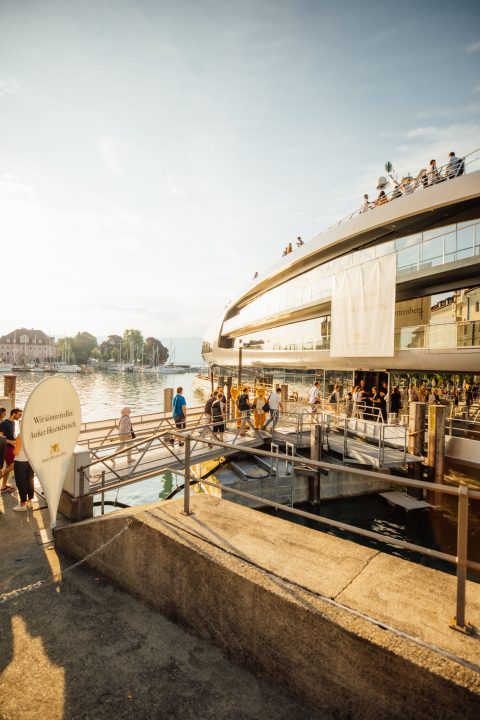
69th Lindau Nobel Laureate Meeting, 04.07.2019, Lindau, Germany Picture/Credit: Julia Nimke/Lindau Nobel Laureate Meetings

First get together of the participants outside the main venue on Lindau island. (Picture/Credit: Julia Nimke/Lindau Nobel Laureate Meetings)
